Gamma Velorum (γ Vel), informally known as Regor, is a multiple star system located in the southern constellation Vela. With a combined apparent magnitude of 1.72, it is the brightest point of light in Vela, outshining Alsephina (Delta Velorum) and Suhail (Lambda Velorum). Lying at an approximate distance of 1,095 light years, the Gamma Velorum system contains the brightest and nearest Wolf-Rayet star to the Sun. The star is one of the nearest supernova candidates to Earth, expected to go out in the astronomically near future.
Star system
Gamma Velorum is a quadruple star system consisting of the primary component Gamma2 Velorum (Gamma Velorum A) and the secondary Gamma1 Velorum (Gamma Velorum B). Gamma2 Velorum is a spectroscopic binary star composed of a carbon-rich Wolf-Rayet star and a massive blue giant, while Gamma1 Velorum is also a spectroscopic double, consisting of a blue giant and a fainter close companion. The estimated age of the Gamma2 Velorum components is between 3.5 and 5.5 million years, while the Gamma1 Velorum stars are believed to be older, with an estimated age of 8 million years.
The two binary pairs – Gamma1 and Gamma2 Velorum – are separated by 41.2’’ and appear as a single star to the unaided eye. The physical distance between the two pairs is at least 15,000 astronomical units. The pairs can be easily resolved in binoculars.
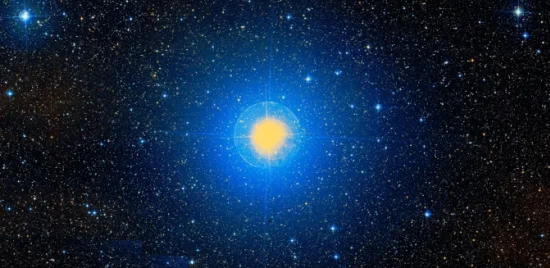
Regor (Gamma Velorum), image: Wikisky
The individual stars, however, cannot be seen in binoculars or in telescopes because they are too close together. The two components of Gamma2 Velorum are separated by only 0.8 to 1.6 astronomical units (Earth-Sun distances) and have an orbital period of 78.5 days. The stars in the Gamma1 Velorum system complete an orbit in only 1.48 days.
Gamma2 Velorum is a double-lined spectroscopic binary (SB2), which means that spectral lines of both stars are visible. The system shines at magnitude 1.83.
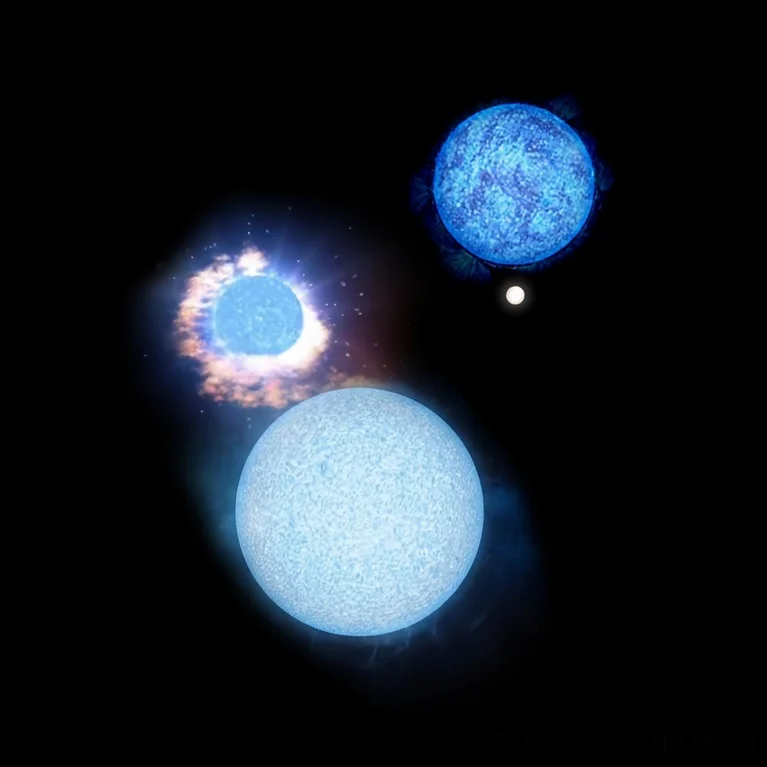
Gamma Velorum star system, illustration: Pablo Carlos Budassi (CC BY-SA 4.0)
The Wolf-Rayet star, the primary component in the Gamma2 Velorum system, has the stellar classification WC8. Like all Wolf-Rayet stars, it is an exceptionally hot, luminous and massive star that has reached an advanced stage of evolution at a very young age and is losing mass at a high rate. Wolf-Rayet stars are believed to end their lives as Type Ib or Type Ic supernovae. They live short lives and are therefore very rare objects. The most massive and one of the most luminous known stars, R136a1 in the Tarantula Nebula in the Large Magellanic Cloud, belongs to this class. It has a mass 215 times that of the Sun and is 6,166,000 times more luminous than our star.
The Wolf-Rayet star in the Gamma2 Velorum system has far less dramatic parameters. It has a mass nine times that of the Sun and a radius about six times solar. With a surface temperature of 57,000 K, it is 170,000 times more luminous than the Sun. The star has already lost most of its mass through a strong stellar wind. It will likely meet its end in a Type Ib supernova, triggered by core collapse.
The secondary component is a blue giant of the spectral type O7.5 III. It is much larger, more massive and more luminous than the Wolf-Rayet star. Even though it is also visually brighter than the Wolf-Rayet star, the latter is considered the primary component because its emission lines are dominant in the system’s spectrum. The blue giant has a mass of 28.5 solar masses and a radius 17 times that of the Sun. With an effective temperature of 35,000 K, it shines with 280,000 solar luminosities.
A 2009 study suggested that the two stars have likely interacted due to their proximity. The study estimated an initial mass of around 35 solar masses for the Wolf-Rayet star and 31.5 solar masses for the blue giant.
The primary component in the Gamma1 Velorum system is a blue giant star of the spectral type B2III. It is 14 times more massive than the Sun. Even though the Gamma1 system is considerably fainter than Gamma2, it would be visible to the unaided eye if the two binaries could be resolved without binoculars. Gamma1 Velorum has an apparent magnitude of 4.27. The fainter secondary component is too close to the blue giant and its spectral type and other parameters are unknown.
Gamma1 and Gamma2 Velorum share a proper common motion, which indicates that they are physical companions. The Gamma Velorum system has other fainter companions that also share a common motion through space and are believed to be members of the Vela OB2 association. Gamma Velorum is the brightest star in Vela OB2.
A 2009 study reported that Gamma Velorum is associated with several hundred pre-main sequence stars in the vicinity, and that these young stars have similar proper motions to Gamma Velorum, as well as to main sequence stars around the Gamma Velorum system and other young stars in the Vela OB2 stellar group.
Facts
On average, Regor is the 35th brightest star in the sky. It is only slightly fainter than Alnitak in the constellation Orion, Alioth and Dubhe in Ursa Major, and Mirfak in Perseus. It is about as bright as Wezen in Canis Major and just outshines Kaus Australis in Sagittarius, Alkaid in Ursa Major, and Sargas in Scorpius.
Regor has the Bayer designation Gamma Velorum even though it is the brightest star in Vela because the constellation Vela does not have an Alpha or Beta star. It was once part of a much larger constellation, Argo Navis, which represented the ship of Jason and the Argonauts. Argo Navis was divided into three separate constellations – Carina, Puppis, and Vela – by the French astronomer Nicolas-Louis de Lacaille in the 18th century. Lacaille kept the Bayer designations from the larger constellation, so the Greek letters Alpha and Beta went to Canopus and Miaplacidus in Carina, Gamma and Delta went to Regor and Alsephina in Vela, Epsilon went to Avior in Carina, and Zeta went to Naos in the constellation Puppis.
Regor is one of the closest supernova candidates to Earth. At a distance of 1,095 light years, it does not pose a threat to our planet. Regor is not as near as IK Pegasi (154 ly), Spica (250 ly), Acrux (320 ly), Antares (550 ly) and Betelgeuse (548 ly) but, like Betelgeuse, it is expected to go out in the relatively near future. IK Pegasi, the nearest supernova candidate, will not meet its end for another 1.9 billion years and will have moved to a greater distance by then.
Name
Gamma Velorum was traditionally known as Suhail al Muhlif and, in modern times, it is known as Regor (pronunciation: /ˈriːɡɔːr/). Neither name has been formally approved by the International Astronomical Union (IAU).
The meaning of the name Suhail al Muhlif is uncertain. Suhail comes from an Arabic word for “the plain”, while al Muhlif refers to “the oath-taker.” Gamma Velorum is one of several southern stars that were traditionally known as Suhail. The other ones were Canopus, Naos (Suhail Hadar), and Lambda Velorum (Suhail al Wazn), which is now formally known as Suhail.
The name Regor is “Roger” spelled backwards. It was given to the star as a joke by Virgil Ivan “Gus” Grissom, one of the three astronauts in the failed Apollo 1 mission. The Roger in question is Roger B. Chaffee, another member of the crew. The Apollo 1 crew invented names for two other stars. Gamma Cassiopeiae was nicknamed Navi (“Ivan” in reverse), while Iota Ursae Majoris (formally known as Talitha) was given the name Dnoces (“Second” spelled backwards), a reference to the third member of the crew, Edward H. White II.
The Chinese know Gamma Velorum as 天社一 (Tiān Shè yī), the First Star of Celestial Earth God’s Temple. The Chinese asterism known as Celestial Earth God’s Temple is formed by Regor with b Velorum (HD 74180), Alsephina (Delta Velorum), Phi Velorum, Markeb (Kappa Velorum), and N Velorum (HD 82668). The asterism is part of the Ghosts mansion, one of the southern mansions of the Vermilion Bird.
Location
Regor is easy to find because it is bright and lies in a region of the sky full of other bright stars. Northern observers can find it using the stars of Canis Major. An imaginary line drawn from Sirius, the brightest star in the sky, through Wezen, the star at the top of a triangle of stars just south of Sirius, leads to Regor.
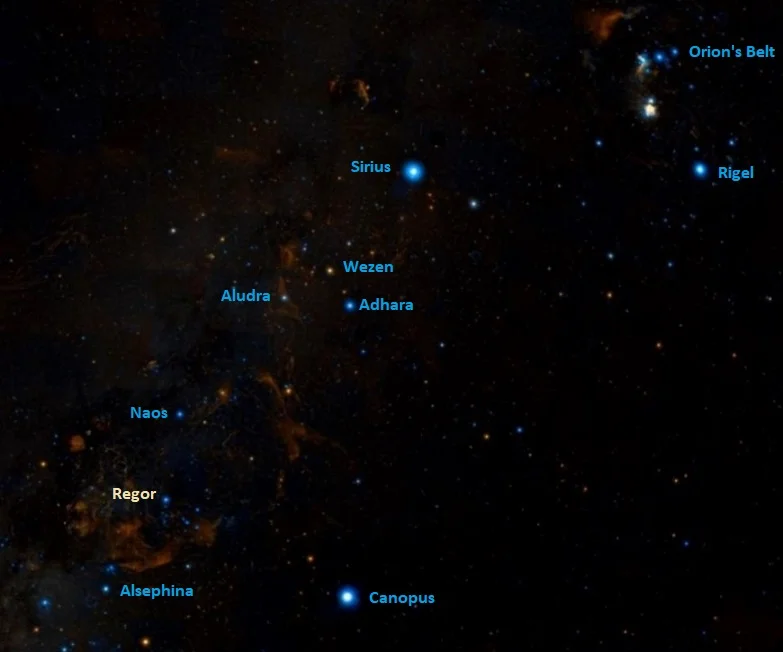
Regor location, image: Wikisky
Southern observers can find Regor using Canopus and the stars of the False Cross: Alsephina, Markeb, Avior and Aspidiske. A line extended from Aspidiske through Alsephina points in the direction of Regor.
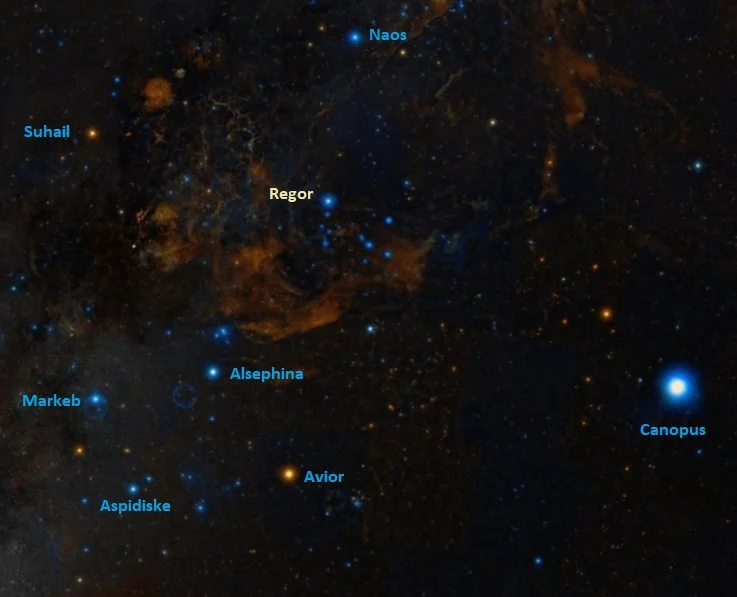
Regor and the False Cross, image: Wikisky
Regor can be used to find the open cluster NGC 2547, which lies in the vicinity of the star. The cluster has an apparent size of 20’ and lies about 1,190 light years away. With an apparent magnitude of 4.7, it is visible without binoculars from areas without light pollution. The cluster is young, with an estimated age of 37.7 million years. It has a physical radius of 2.61 light years.
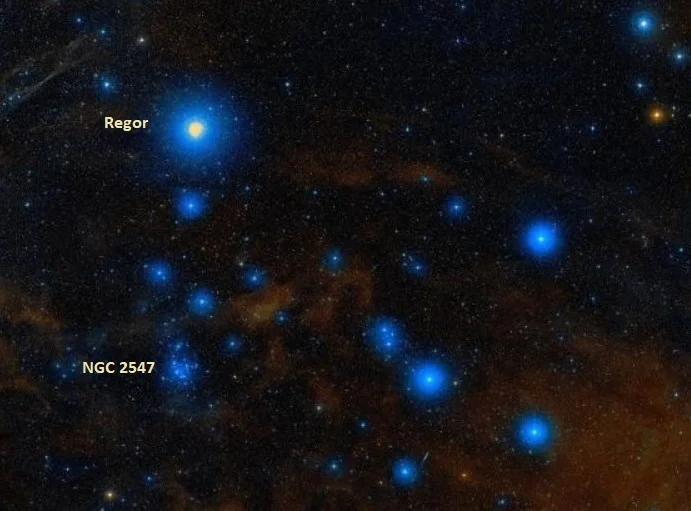
Regor and NGC 2547, image: Wikisky
Constellation
Regor is located in the constellation Vela. Representing the sails of Argo Navis (the Ship Argo), Vela was once part of the larger Greek constellation Argo Navis, which represented the ship on which Jason and the Argonauts sailed on their quest for the Golden Fleece. Argo Navis was divided into three smaller constellations – Carina (the keel), Puppis (the stern), and Vela (the sails) – by the French astronomer Nicolas Louis de Lacaille in the 18th century.
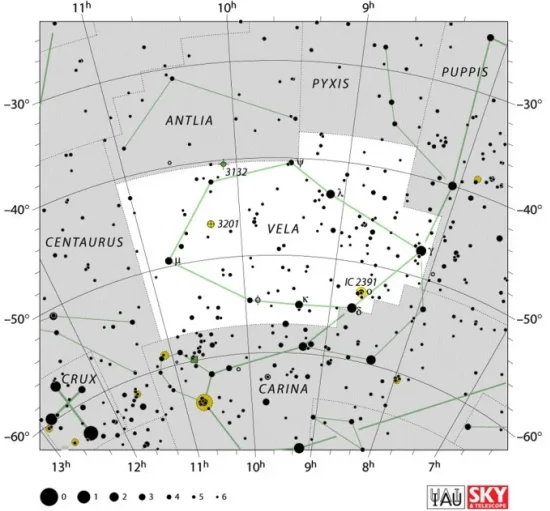
Vela constellation map by IAU and Sky&Telescope magazine
Vela stretches across 500 square degrees of the southern sky and is the 32nd largest of the 88 constellations. It contains five stars brighter than magnitude 3.00, two of which – Alsephina (Delta Velorum) and Markeb (Kappa Velorum) – form a diamond-shaped asterism known as the False Cross with Avior (Epsilon Carinae) and Aspidiske (Iota Carinae) in the neighbouring Carina.
Interesting stars in Vela include the multiple star system Delta Velorum, an eclipsing binary, the orange supergiant Suhail (Lambda Velorum), a slow irregular variable, the yellow supergiant or bright giant AH Velorum, a classical Cepheid variable, the nearby binary brown dwarf Luhman 16, the third nearest star system to the Sun, and the blue subgiant Omicron Velorum, the central star in the bright, large Omicron Velorum Cluster.
Vela is home to many notable deep sky objects. The best-known ones are the planetary nebulae NGC 2899 and the Southern Ring Nebula (NGC 3132), the globular cluster NGC 3201, the peculiar galaxy NGC 3256, the open clusters NGC 2547 and NGC 2670, and the emission nebulae Gum 20 (RCW 36) and Gum 12 (the Gum Nebula), which stretches across 36 degrees and contains the Vela Supernova Remnant and the Vela Pulsar.
The best time of year to observe the stars and deep sky objects of Vela is during the month of March, when the constellation rises high in the evening sky. The entire constellation is visible from locations between the latitudes 30° N and 90° S.
The 10 brightest stars in Vela are Gamma2 Velorum (mag. 1.83), Alsephina (Delta Vel, mag. 1.96), Suhail (Lambda Vel, mag. 2.21), Markeb (Kappa Vel, mag. 2.48), Mu Velorum (mag. 2.69), N Velorum (HD 82668, mag. 3.16), Phi Velorum (mag. 3.53), Omicron Velorum (mag. 3.60), c Velorum (HD 78004, mag. 3.75), and b Velorum (HD 74180, mag. 3.81).
Gamma2 Velorum
| Spectral class | WC8 + O7.5III |
| Variable type | Wolf-Rayet |
| U-B colour index | −0.94 |
| B-V colour index | −0.25 |
| Apparent magnitude | 1.83 (1.81 – 1.87) |
| Absolute magnitude | -4.23, -5.63 |
| Distance | 1,096 light years (1,073 – 1,122 ly) or 336 parsecs (329 – 344 pc) |
| Parallax | 2.92 ± 0.30 mas |
| Radial velocity | +15.00 ± 3.1 km/s |
| Proper motion | RA: –6.07 ± 0.30 mas/yr |
| Dec.: +10.43 ± 0.32 mas/yr | |
| Constellation | Vela |
| Right ascension | 08h 09m 31.95013s |
| Declination | –47° 20′ 11.7108″ |
| Names and designations | Regor, Suhail Al-Muhlif, Gamma2 Velorum, HD 68273, HR 3207, HIP 39953, WR 11, FK5 309, SAO 219504, GC 11105, GCRV 5419, CD−46°3847, CPD-46 2202, ALS 980, PPM 312662, GUM 12a, Hen 3-127, PLX 1940.01, JP11 1639, IRAS 08079-4711, 2MASS J08093195-4720115, UBV 7815, TYC 8140-6533-1, IDS 08065-4703 A, CCDM J08095-4721A, WDS J08095-4720A, WDS J08095-4720Aa,Ab |
WR
| Spectral class | WC8 |
| Variable type | Wolf-Rayet |
| Absolute magnitude | -4.23 |
| Mass | 9.0 ± 0.6 M☉ |
| Luminosity | 170,000 L☉ |
| Radius | 6 ± 3 R☉ |
| Temperature | 57,000 K |
| Age | 3.5 – 5.5 million years |
O
| Spectral class | O7.5III |
| Absolute magnitude | -5.63 |
| Mass | 28.5 ± 1.1 M☉ |
| Luminosity | 280,000 L☉ |
| Radius | 17 ± 2 R☉ |
| Temperature | 35,000 K |
| Age | 3.5 – 5.5 million years |
Gamma1 Velorum
| Spectral class | B2 III |
| U-B colour index | -0.92 |
| B-V colour index | -0.22 |
| Apparent magnitude | 4.27 |
| Absolute magnitude | -3.62 |
| Parallax | 3.5562 ± 0.3303 mas |
| Radial velocity | +9.7 ± 1 km/s |
| Proper motion | RA: -6.706 ± 0.581 mas/yr |
| Dec.: +10.775 ± 0.594 mas/yr | |
| Mass | 14 M☉ |
| Age | 8 million years |
| Constellation | Vela |
| Right ascension | 08h 09m 29.3182203760s |
| Declination | –47° 20′ 43.034677104″ |
| Names and designations | Gamma1 Velorum, HD 68243, HR 3206, SAO 219501, CD−46°3846, CPD-46 2202B, GC 11103, GCRV 5417, GSC 08140-06534, JP11 1638, PPM 312661, ALS 14916, 2MASS J08092932-4720430, NSV 3930, UBV 7810, TYC 8140-6534-1, Gaia DR2 5519266900766220800, CCDM J08095-4721B, IDS 08065-4703 B, WDS J08095-4720B, WDS J08095-4720Ba,Bb |